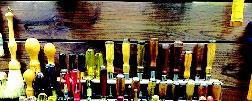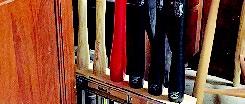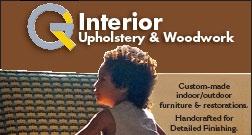
17 minute read
WoodCentral.com
March-April, 2020 Vol. 33, No. 2
WOO DWOR KER WEST (ISSN 1080-0042) is published bi-monthly to promote craftsmanship in woodworking throughout the Western U.S. The information contained within has been collected in cooperation with external sources and is believed to be accurate. The views expressed are not necessarily the views of Woodworker West. Copyright, Woodworker West, 2020. RONALD J. GOLDMAN – Publisher PAM GOLDMAN – Editor Mailing address: P.O. Box 452058 Los Angeles, CA 90045 Telephone: (310) 216-9265 Fax: (310) 216-9274 E-Mail: editor@woodwest.com Web Site: http://www.woodwest.com Subscriptions: Mail subscriptions are $12 per year; $20 for two years. For Canada, subscriptions are $20 per year; call for other countries. Advertising: Call for rates. Submission of unsolicited articles and correspondence is encouraged and may be edited for publication. Submissions must be accompanied by a self-addressed, stamped envelope.
Advertisement
SubScriber information The expiration date of your Woodworker West subscription is printed on the mailing label of each issue. If you have any questions about your subscription, call us at: 310-216- 9265.
Pam and I are very disappointed at the cancellation of World Wood Day (WWD) in Tokyo, due to fears of the Novel Coronavirus (CoV). We were eagerly looking forward to meeting up with old friends in this exotic locale, as well as reconnecting with a number of foreign craftsmen that we met at WWD held in Long Beach, 2017. Having had a wonderful time previously, we wanted to take part in all the festivities. I feel particularly sorry for Mike Hou, his Taiwanese team, and the section organizers that worked so hard to put together this massive endeavor, coordinating venues and the hundreds of woodworkers from around the world who were to participate. They certainly are suffering a huge financial loss, though they did not have much choice given the unknown state of health conditions weeks away. This is not the first time WWD has been affected by health concerns. The 2017 conference initially was planned for Brazil, but plans changed with the appearance of the Zika virus. In that case, enough lead-time was available to move to another location, which was Southern California. This time, two months notice was not sufficient. Hopefully, this experience will not discourage future plans.
I also want to say a few words about the passing of Simon Watts. A sweet, gentle, and generous man, I met him in 2003, after his apartment was strangely “emptied” (see page 11), and he had begun reconstructing his furnishings. He lived up one of those steep San Francisco hills, on the top floor of a 3-story walkup. Though I was healthy at the time, I needed to rest after walking uphill on his the street from Fisherman’s Wharf. As I sat outside on the steps to his building catching my breath, up comes prancing 70+ year old Simon, suffering no problem at all with the climb. This demonstrated both his stamina, as well as his spirit. We had a delightful rest of the day and maintained a frequent email connection afterwards.
Publisher Ron Goldman
moving? Address changes should be sent to: Woodworker West PO Box 452058 Los Angeles, CA 90045 or email us at: editor@woodwest.com
Include the old address, as well as the new address. The post office does not forward the magazine.















News and Views from WoodCentral.com by Ellis Walentine
IDEAS FOR OR GANI ZIN G YOUR SHO P Woodworking shops are complicated places, each with its unique assortment of tools, gadgets, and gear. Keeping everything organized isn’t easy, but it pays off in efficiency and satisfaction. Recently, one of our members, unhappy with his current shop arrangement, asked for suggestions for organizing his most-often used tools, prompting an outpouring of personal experiences and workable strategies from our other visitors…


“I used to have trouble putting tools away, so I built a long bench for my radial arm saw (RAS) against the wall behind my workbench. The b e n c h d o e s double duty as a landing p l a c e f o r miscellaneous stuff, while I’m working at my bench. I also hung many of my hand tools on the wall a b o v e t h e R A S b e n c h , i n c l u d i n g a t i l l f o r m y s a w s a n d s o m e o p e n cabinets for hand planes a n d o t h e r things.”


“For above, the most useful thing that I did was to build a little stand (below) for my most used tools—such as my everyday chisels, screwdrivers, awls, marking gauges and such. It’s easy to find familiar tools with them in plain view and to replace them when I’m done without having to open or close a drawer.”

“All I need is to drop one vital tiny brass screw on the floor to realize why it is important to keep the floor clear of sawdust.” “I keep all the of my small hand and power tools in the drawers under the radial arm saw bench that I built. I don’t find it too much trouble to put stuff back when I’m done with it. I also keep my layout tools, squares, rules, pencils, marking gauges, etc. in drawers to keep them handy and dust-free.”
“Besides organizing what you have, consider having fewer tools. This is the perfect time to weed out duplicates and broken items. If you have tools that are better than what you currently use, fix them up and replace the others. Put what you replaced into a box for donation. Get rid of stuff. If you haven’t looked for it in the last 90 days, off it goes. And remember that antique tools probably have less value now than when you got them; most of the younger generation couldn’t care less about tools.”
“My saws are on a till behind my bench, my regularly-used planes are under the bench, and the dogs and hold fasts are on top. My chisels are on the wall. Things that I use less frequently are stored in another room, on the inexpensive racks that you’d find at the big box stores. Most importantly for me, nothing is in a closed cabinet in my store room, else I would soon forget that they existed.”
“I do not replace tools mid-process, and if the process is complicated, I can get to the point that soon there are forty things on my bench. Cleaning and organizing is agonizing for me, so I try to do it in a rhythm. The rhythm is always about 80% of ‘as fast as I can rush through this’ and inevitably, it always works out to be faster and less trouble.”
“Don’t allow offcuts and scraps to take over your shop. I am guilty of this. I’m a pack rat. I just can’t bring myself to throw out interesting pieces of wood that I paid a lot for.”
“I keep my commonly used lathe tools on a stand that I built out of plywood, with 2-in. PVC pipe to hold the chisels. Little-used ones go in the drawer beneath the lathe. My hand tools go into two drawer cabinets near my workbench. Drills, bits and accessories go in a drawer unit near my drill press, and router bits go in a storage cabinet that hangs on my router table.”
“One thing that I have managed to discipline myself into doing is to put ten things away when I walk into the shop. Doesn’t make much of a dent, but it helps. The funny part is I might just go in the shop for a pencil, but I have to put ten things away before I can take a pencil.”
“I define a particular storage place for every tool, and I never put any other tool in that spot. If I am finished with a tool but feel disorganized, I put it down on my bench. This is a reflex action that I can’t seem to break, so I just live with it. If the bench doesn’t have the needed space to do what I need to do next, I stop and put tools away, at least enough to clear the required space.”
“You definitely need racks for your most often used tools. You will save a lot of time by minimizing steps when you need them and when you put them away. My racks allow me to drop tools into them from the top, and they are moveable, using French cleats. I have the bottom half of the cleats in several places around the shop, when and where I use the tools away from front and center of the main workbench.”
“Matched tool set handles are a really bad idea, unless you are just a collector. You need a unique handle on every one of your commonly used tools. It makes them easier to find, easier to identify which one might be missing, and easier to put away.”
“I have six magnet bars that I use to hold all my screw bits, punches, my low-end chisels and any other tools that I may need readily and don’t want to have buried in a drawer.”
“Peg board may be an inefficient use of wall space, but things I use frequently are right there—marking tools, screw drivers, a few chisels, hammers and mallets—you get the idea. Also, the peg board hooks are convenient for storing little items that would otherwise be lost to history.”


“ The lathe area has a cabinet for power tools, and the chisels are in s l i d i n g r a c k s a t t h e sides.”
“I have drawers for drills and accessories, one for sanding supplies, and another for router bits and router table accessories. I also have a drawer for fasteners. There’s a label on the front of each drawer telling the main content of that drawer.”


“The wall behind my bench (below), which is where I do much of the work, is storage for measuring tools. In addition, there are tool racks for chisels, etc.” “Unless work is being impaired, I don’t purposely clean and organize. The only thing I have done in decades to lessen chaos is to acquire the discipline to notice anything that could be put away. If the item is not out of my way, I pick it up and deposit it in its storage location. I also believe that everything has a home. The home may be a pile of apparent clutter, but I know what is there and can generally find what I need when I need it. I am annoyed by walking on shavings though, so the floor around the bench stays tidy.”

“‘Front and center’ is my term for that place in my shop where I do most of my sketching, thinking, experimenting, and fine work. I’m sure most of us have such a favorite work place. When I decide to put things away, that is the space I start with.”

Participate in future surveys at WoodCentral.com Send topic suggestions to: webmaster@woodcentral.com
“I am very much of the mindset that every tool has it's place, and belongs there. Before I buy a tool, there has to be a place for it to live. In my long-lost youth, I discovered that it did not cost me a penny more to drive my car with a full tank of gas as opposed to just above empty all the time. Same with putting tools away after use; just a little effort is all it takes.”

“I built wide stools into all my shop windows and drill them for awls chisels,etc. Clamp brackets go across the top of the window. Clamps don’t block much light.”
“I keep a couple of rare earth magnets on the drill press column to hold drill bits in use. A rare earth magnet is also useful to hold that drill chuck key. They hold small and easy-to-lose items at various stations, such as Allen/hex keys or wrenches.”
“I use rare earth magnets on the bottom surface of my overhead air cleaner. Light ferrous tools, like compasses, marking knives, 6" rules, etc., can be hung from them, making these tools easy to pick up and put back.”


bridg e city’s lower prices Always wanted a Bridge City hand tool, but found it too expensive. Now, might be the time to fulfill your dream. Bridge City Tool Works, known for its high-quality, heirloom hand tools and limited quantity production, is cutting prices. With the new company structure offering a wider distribution market, global demand has resulted in a shift to more affordable pricing. “Our significant sales increase has lead to meaningful manufacturing cost savings, allowing us to substantially reduce retail prices and make these beautiful tools affordable for woodworkers everywhere,” explains President Mark Strahler. These new prices are evident at its website: www.bridgecitytools.com/. new l ine of harvey power saws Harvey Industries, a manufacturer of woodworking machinery for other companies, brings its Ambassador series line to the U.S. for the small shop and home market. Initially, Harvey will be offering four machines: C200-30 10" 2hp table saw, C300-50 10" 3hp table saw with 50-inch fence, C300-30 10" 3hp table saw with 30-inch fence, and C14 14" 3hp band saw. Factory-direct pricing is available. For info, visit the website: www.harveywoodworking.com.
NE W HAND TOO L DISTRIBUTOR Heartwood Tools is a new specialty on-line hand tool distributor, specializing in unique tools, not otherwise represented in the U.S. Specifically, it carries the Australian manufacturer HNT Gordon hand planes, spokeshaves, and accessories, as well as Florip, Sterling, Sigma Power, and Atoma Diamond. This is a tool store for woodworkers, by woodworkers. For info, visit the website: www.heartwoodtools.com/.
IPE WOO D WARNIN G Ipe, also called Brazilian Walnut, has been gaining in popularity, particularly for use in outdoor furniture and applications. However, some decking companies have begun marketing Ipe boards, which in fact are composite plastic. Deception also has extended to Teak and Brazilian Cherry. Buyers are encouraged to purchase from reputable dealers.
REE L INTRO DUCES HE MPWOO D Reel Lumber Service in Anaheim, CA has announced it is the first company in the world to stock Hempwood. The wood substitute is made via a patented process that utilizes bio-mimicry to transform hemp fibers and protein based bonding agents into a viable substitute for anything solid Oak can be used for. All hemp growth and material production is conducted in the U.S., and the hemp is grown using sustainable methods, which helps eliminate deforestation.
“We believe this eco-friendly alternative to traditional lumber will revolutionize the industry,” says Marketing Director Dan Clark. “Unlike hardwood lumber, it only takes 120 or so days to take a hemp seed all the way to cultivation.”
To demonstrate its use, five local companies were given samples to create pieces for the Mystery Product Launch. Hempwood is available in plain sawn and rift sawn 4/4 boards. Sample boards are available. For info on Hempwood, visit the website: www.reellumber.com/hempwood/.


One of the sample pieces displayed at Reel Lumber’s product launch of Hempwood was this table, crafted by Brandon Munoz at Monkwood Studio.




Woodw orking ICON SIMON WATT S Long time woodworking icon Simon Watts passed away in January, six days after celebrating his 90th birthday. He was a fine woodworker, boat-builder, and author.
Trained in England as a civil engineer, he emigrated to Canada in 1953 to design highways and timber bridges. After 4 years, he realized that he was better suited to working at a smaller scale—items he could make himself, such as furniture. “I had no training in this field but learned by working alongside artisans that knew a great deal more than I did. Eventually, I set up shop in Vermont, making furniture when it was ordered, but kept food on the table by doing all kinds of repair work.” When Fine Woodworking magazine emerged in the mid1970s, he started writing articles on his current furniture projects. In 1983, Taunton Press commissioned a book, Building a Houseful of Furniture, including 43 furniture designs. Later, he would also write for American Woodworker, Woodwork, and Woodworker’s Journal magazines; publish two editions of Working with Wood, featuring 50 furniture plans; and produce the DVD set of Simon Watts Woodworking, complete building instructions for 50 years of woodworking.
Always interested in boats, he took a 3-month hiatus from furnituremaking to work at the Brooklin Boatyard in Maine in 1989. This whetted his appetite for boat building, so he moved his furniture business to Nova Scotia, where he furthered his boat making skills. He then wrote articles for Wooden Boat magazine and published plans for a half-dozen boats.
He began living part-time in San Francisco in the 1990’s, where he became co-director of the Arques School for Traditional Boatbuilding. He also experienced the most bizarre event. In 2003, he returned from a Canadian vacation to find his entire apartment emptied, even the frozen peas from the refrigerator. He suspected that his landlord might have been responsible, trying to encourage departure from his 15-year rent-controlled home, but being a stubborn man in his late 70s, he stayed another 10 years, simply reconstructing his furnishings using the plans from his books.
The items most missed from the “move out” was a collection of drawings by his father, a well-known illustrator for British publications including the humor magazine Punch. Simon was in the process of assembling the work for publication of a book.
A celebration of Simon’s life will take place, Mar. 7, in Exeter, NH. Details are posted at: www. facebook. com/simon. watts.560/.



WEN DY MARUY AMA WIN S FE LLOWSHI P Wendy Maruyama, studio artist and former head of the San Diego State Furniture Program, has been honored with the United States Artists Fellowship.
The U.S. Artists was founded in 2006 to illuminate the value of artists to American society and address economic challenges. Each year, individual artists and collaboratives are anonymously nominated, and the organization selects finalists to receive a $50,000 prize.
Wendy has been making innovative work for 40 years. While Maruyama’s early work combined ideologies of feminism and traditional craft objects, her newer work moves beyond the boundaries of traditional studio craft and into the realm of social practice.
She previously received several National Endowment for the Arts Grants for Visual Artists; the Japan/US Fellowship; a Fulbright Research Grant, and the Furniture Society Award of Distinction. But most notable is the number of her former students teaching and leading furniture programs across the U.S. You can see her work at the website: www.wendymaruyama.com/.
The first disc of Simon Watts Woodworking DVD set, with plans and instructions for furniture and boat building.












